West Highland Terrier - Breed Facts & Characteristics
Notable for their snowy white coats, West Highland White Terriers (or ‘Westies’) are sprightly, solid and surprisingly strong. Full of character, these wee little Scots are also intelligent, curious and can be quite feisty. Forming strong bonds with their human families, they will sound the alarm over any perceived threat, making them good watchdogs too. Originally bred for ratting, Westies still retain something of that tenacious hunting instinct today and can be quite determined when they want something.
Official name: West Highland White Terrier
Other names: Poltalloch Terrier, Roseneath Terrier, Westie
Origins: Scotland
Drooling tendencies
1 out of 5Grooming needs
3 out of 5Shedding Level
2 out of 5Barking tendencies
4 out of 5Energy level*
1 out of 5Compatibility with other pets
4 out of 5Warm weather?
3 out of 5Cold weather?
3 out of 5Suited to apartment living
4 out of 5Can stay alone
2 out of 5Family pet?*
4 out of 5
| Male | Female |
|---|---|
| Height | Height |
| 0 - 28 cm | 0 - 26 cm |
| Weight | Weight |
| 6.8 - 9 kg | 6.8 - 9 kg |
| Life stages | |
|---|---|
| Puppy | Adult |
| 2 to 10 months | 10 months to 8 years |
| Mature | Senior |
| 8 to 12 years | From 12 years |
| Baby | |
| Birth to 2 months | |
Drooling tendencies
1 out of 5Grooming needs
3 out of 5Shedding Level
2 out of 5Barking tendencies
4 out of 5Energy level*
1 out of 5Compatibility with other pets
4 out of 5Warm weather?
3 out of 5Cold weather?
3 out of 5Suited to apartment living
4 out of 5Can stay alone
2 out of 5Family pet?*
4 out of 5
| Male | Female |
|---|---|
| Height | Height |
| 0 - 28 cm | 0 - 26 cm |
| Weight | Weight |
| 6.8 - 9 kg | 6.8 - 9 kg |
| Life stages | |
|---|---|
| Puppy | Adult |
| 2 to 10 months | 10 months to 8 years |
| Mature | Senior |
| 8 to 12 years | From 12 years |
| Baby | |
| Birth to 2 months | |
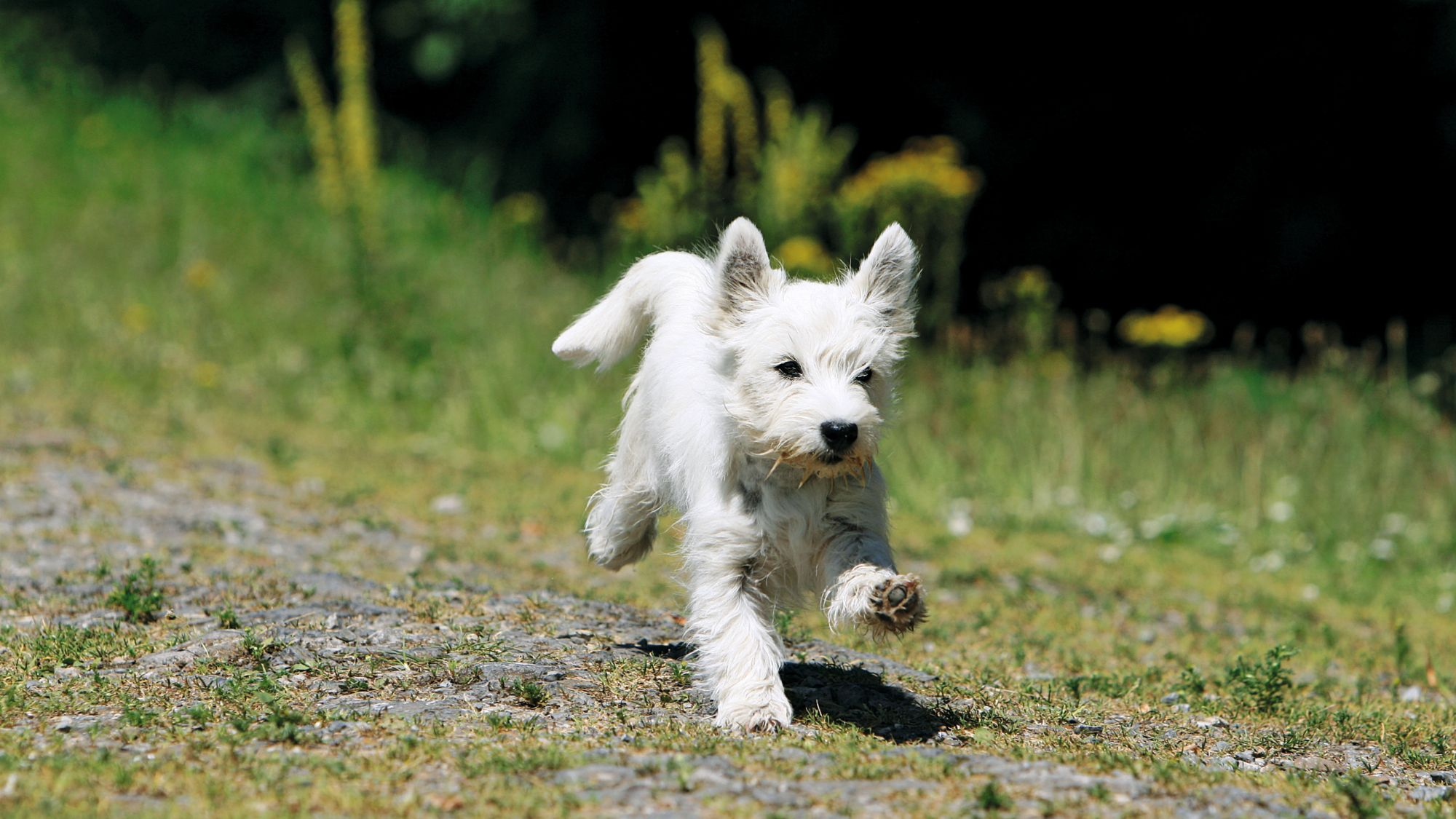
Get to know the West Highland White Terrier
All you need to know about the breed
One of the most popular breeds of terrier, West Highland Whites have bags of personality. Sociable, friendly and smart, they definitely have a mind of their own. This can make training a Westie a little more challenging, but with patience – and a few healthy treats – they’ll get there.
Generally, though, these diminutive dogs adapt well to most domestic set-ups. Growing to a maximum height of around 28cm (11 inches), Westies will do fine in an apartment situation, as long as they have a decent amount of exercise every day. Just one thing to bear in mind is that they can occasionally react with a snap if feeling threatened, so it’s best to keep them supervised with small children.
Originating in the Scottish Highlands, where they were bred to hunt rats and foxes, West Highland White Terriers still retain something of that instinct today. As such, they are the first to chase other animals or humans, and always enjoy a good game in the garden. Westies also thrive on exploring, digging and sniffing things out – whether you’d like them to or not.
Surprisingly strong for their small size, West Highland White Terriers are made of pretty stern stuff. A fairly healthy and robust breed of dog, they have a good lifespan too. In fact, Westies can easily live well into their teens.
Their distinctive white double-coat is actually quite coarse, to protect them from the elements, and they move faster than you might think. Their dark brown eyes are usually bright and alert, and their pricked ears are constantly listening out for the slightest sound.
Quite protective when they are on their own territory, the West Highland White Terrier is also quick to bark at any approaching strangers. This means they make a good guard dog – though are less suited to environments where noise might be an issue. Other than that, however, these lively little terriers will make a terrific addition to any household.
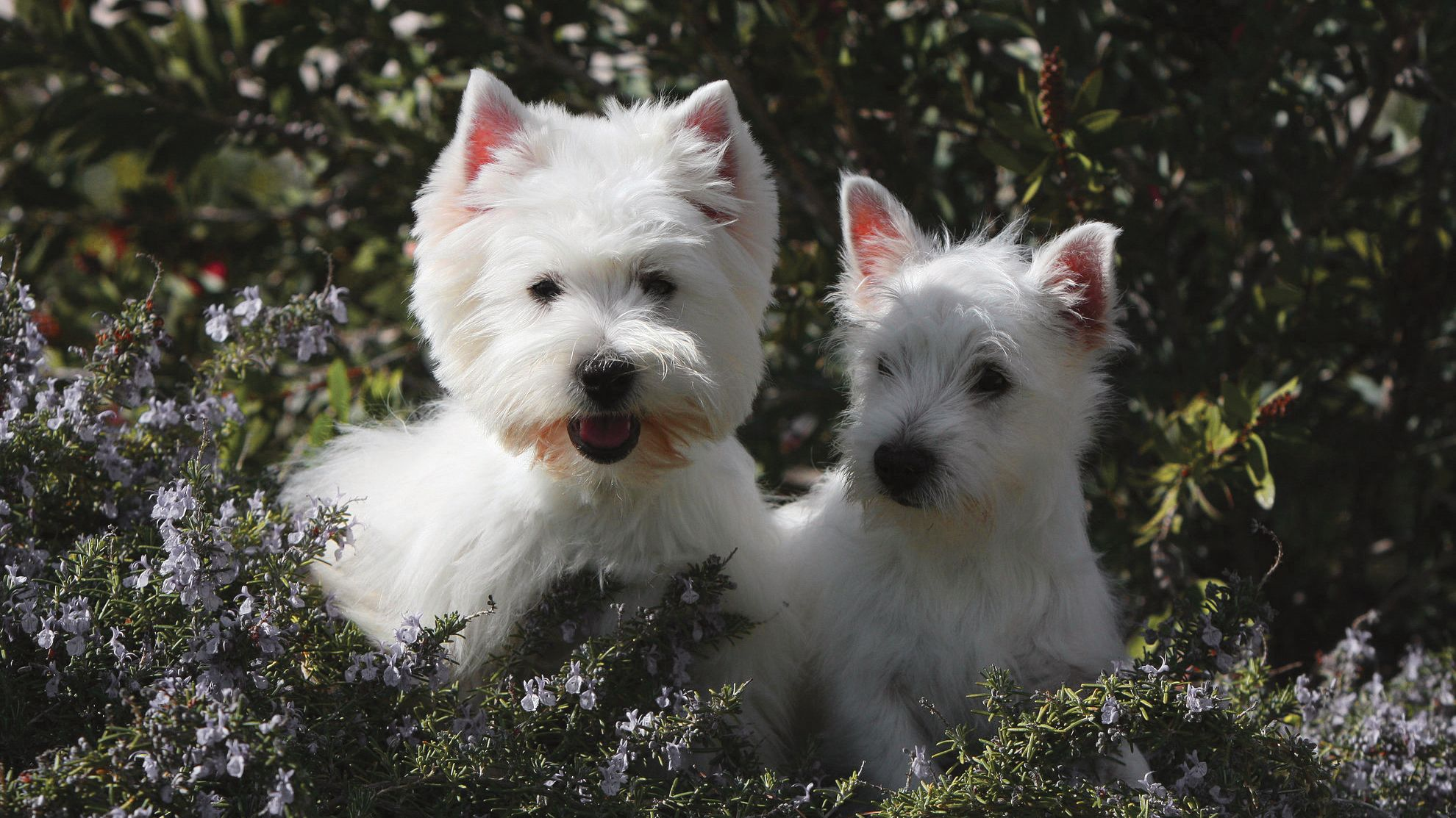
2 facts about West Highland White Terriers
1. Going underground
Given their background as hunting animals, when they would burrow underground to flush out their prey, the West Highland White Terrier is always up for a good dig today. In fact, the name “terrier” itself derives from the word “terra” meaning earth.
2. Home alone (or not...)
Despite having an independent streak, West Highland White Terriers shouldn’t be left on their own for too long – otherwise you may return to find your newspaper chewed up. If you do have to leave your Westie, a brisk walk or run beforehand will help to tire them out. For information on training your Westie, see below.
History of the breed
Originating in the rugged terrain of Scotland, the history of the West Highland White Terrier begins several hundred years ago. Bred to hunt foxes and rats, they would charge around the Scottish countryside retrieving quarry for their masters with their powerful teeth.
In fact, the story goes that their snowy white coat – which once came in a variety of colors – has its roots in their hunting heritage. In the 1800’s, a dog belonging to a certain Colonel Edward Malcolm of Poltalloch, on the west coast of Scotland, was accidentally shot dead after being taken for a fox. As a result, they were henceforth bred to be white to avoid the mistake happening again.
Originally called the Roseneath Terrier – after the Scottish estate from which the white line emanated – they became known as the West Highland White Terrier from the late 1800’s. The breed was officially recognised by the Kennel Club of the United Kingdom in 1907, and by the American Kennel Club in 1908.
Interestingly, Scotland has become somewhat synonymous with terriers. As well as the Westie, this northerly country can also lay claim to the Cairn, Skye, Scottish and Dandie Dinmont terriers.
From head to tail
Physical characteristics of West Highland White Terriers
3.Body
2.Ears
4.Coat
5.Tail
1.Head
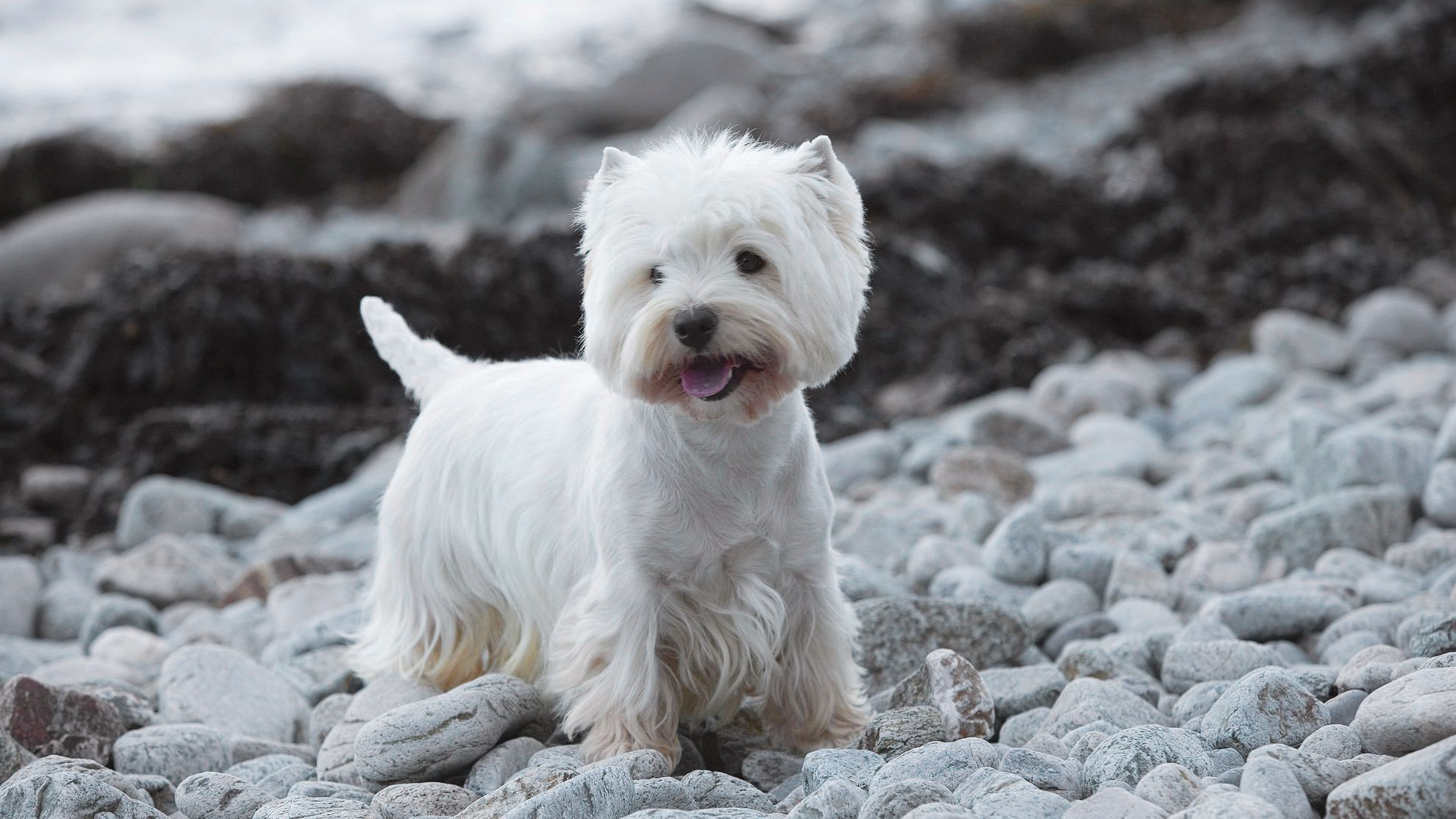
Things to look out for
From specific breed traits to a general health overview, here are some interesting facts about your West Highland White Terrier
One thing that can be a problem is their sensitive skin
West Highland White Terriers belong to the group of dogs that can be prone to ‘allergic dermatitis’ – or, to put it more simply, allergies. An overreaction of the immune system, these often result in itching that the dog will try to relieve by licking, scratching, biting or rubbing. This behaviour can cause more skin lesions and open the gate to other infectious agents such as yeasts or bacteria. Triggers can include specific foods, environmental allergens and even fleas. Fortunately, there is plenty that can be done and – together with your vet – you can find a routine to make your Westie more comfortable. This can range from special socks to various therapeutic options to tailored diets.
Like other small-breed dogs, they can also suffer from dental problems
As a result, your West Highland White Terrier should have their teeth brushed as often as possible – and ideally daily. In addition, they should also have regular dental check-ups with your vet. Once again, diet can play a big part in the health of their teeth too. For instance, the right-shaped kibble will encourage them to chew and therefore slow down the formation of dental plaque. A formula containing calcium chelators will also help to reduce tartar formation. For more on the best nutrition for your West Highland White Terrier, see our ‘Healthy Diet, Healthier Dog’ section.
Another thing to watch out for: a condition called 'Westie's jaw'
One of the genetic disorders to which the breed can be prone is something called craniomandibular osteopathy (CMO). More commonly known as ‘Westie’s jaw’, this disorder of the skull causes a swelling and thickening of the jaw bones. This can result in difficulty chewing and swallowing, as well as drooling, and can be quite painful – although the discomfort may diminish at skeletal maturity (10 to 12 months of age). It’s best to keep an eye out for any signs and consult your vet if needed to alleviate symptoms. Also, it is recommended not to breed from affected animals, so check with the breeder before acquiring a puppy. Both parents should be clear of the condition.
Healthy diet, healthier dog

When choosing food for a West Highland White Terrier, there are many factors to consider: their age, lifestyle, activity level, physiological condition, and health including potential sickness or sensitivities. Food provides energy to cover a dog’s vital functions, and a complete nutritional formula should contain an adjusted balance of nutrients to avoid any deficiency or excess in their diet, both of which could have adverse effects on the dog.
Clean and fresh water should be available at all times to support your dog’s urinary health. In hot weather and especially when out exercising, bring water along for your dog’s frequent water breaks.
The following recommendations are for healthy animals. If your dog has health problems, please consult your veterinarian who will prescribe an exclusive veterinary diet.
A West Highland White Terrier puppy’s requirements, in terms of energy, protein, minerals and vitamins, are much greater than those of an adult dog. They need energy and nutrients to maintain their body, but also to grow and build it. Until they are 10 months old, a West Highland White Terrier puppy's immune system develops gradually. A complex of antioxidants - including vitamin E - can help support their natural defences during this time of big changes, discoveries, and new encounters. Their digestive functions are different from an adult West Highland White Terrier, too: their digestive system is not mature yet so it’s important to provide highly digestible proteins that will be effectively used. Prebiotics, such as fructo-oligosaccharides, support digestive health by helping balance the intestinal flora, resulting in good stool quality.
Similarly, a puppy’s teeth – starting with the milk teeth, or first teeth, then the permanent teeth – are an important factor that needs to be taken into account when choosing the size, shape, and texture of kibble. This intense growth phase also means high energy needs, so the food must have a high energy content (expressed in Kcal/100g of food), while concentrations of all other nutrients will also be higher than normal in a specially formulated growth food. It is recommended to split the daily allowance into three meals until they are six months old, then to switch to two meals per day.
Throughout their life, it is important to avoid feeding West Highland White Terriers human foods or fatty snacks. Instead, reward them with kibble taken from their daily meal allowance, and strictly follow the feeding guidelines written on the package in order to prevent excessive weight gain.
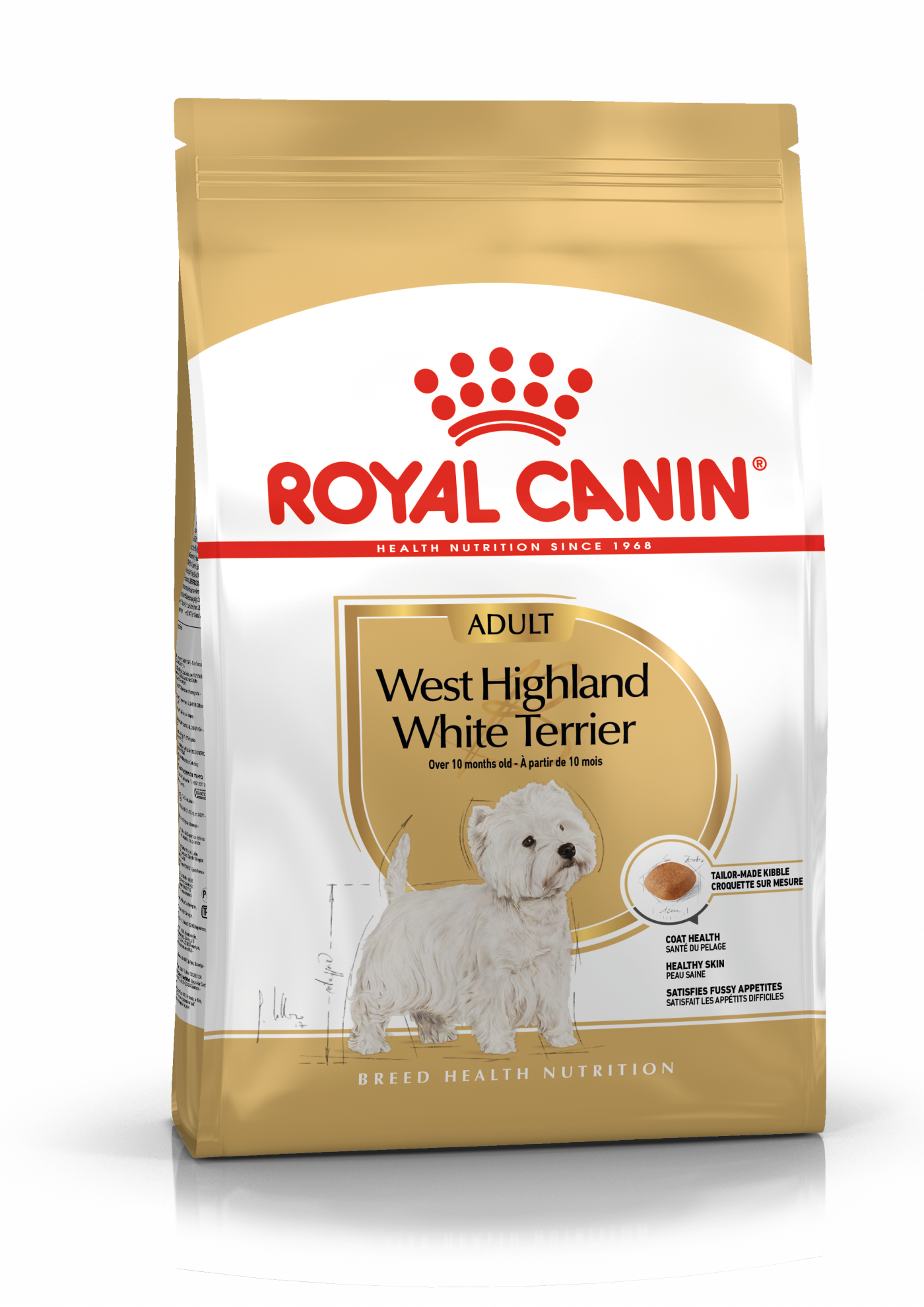
The main nutritional goals for adult West Highland White Terriers are:
Maintaining an ideal body weight by using highly digestible ingredients and keeping the fat content at a sensible level.
Preserving the health and beauty of the skin and coat with the enriched addition of essential fatty acids (especially EPA-DHA), essential amino acids, and B vitamins to support the skin’s “barrier” function. The West Highland White Terrier has a rough coat and delicate skin.
At adult age, small breed dogs are exposed to oral and dental disorders, more precisely accumulation of dental plaque and tartar. The West Highland White Terrier’s teeth and jaws need a lot of protection. A formula containing calcium chelators will help reduce tartar formation and help support daily oral hygiene. Small breed dogs are well known for being fussy eaters. Exclusive formula and flavourings, as well as a kibble size with a special texture, will help stimulate their appetite. Small breed dogs are prone to urinary stones; a diet that supports a healthy urinary system is recommended.
For West Highland White Terriers living mainly indoors, highly digestible proteins, an appropriate fibre content, and very high quality carbohydrate sources will help reduce faecal smell and amount. Because an indoor lifestyle often means less exercise, an adapted calorie content, which meets the reduced energy needs, and a diet that contains L-carnitine, which promotes fat metabolism, can help maintain an ideal weight. Apart from an indoor lifestyle, neutering is also a factor in overweight dogs.

After 8 years old, West Highland White Terriers start facing the first signs of ageing. A formula enriched with antioxidants will help maintain their vitality and an adapted phosphorus content will support their renal system. Ageing is also accompanied by the modification of digestive capacities and particular nutritional requirements, so food for older West Highland White Terriers should have the following characteristics:
Higher vitamin C and E content. These nutrients have antioxidant properties, helping to protect the body’s cells against the harmful effects of the oxidative stress linked to ageing.
High-quality protein. Contrary to a widely held misconception, lowering the protein content in food brings little benefit in limiting kidney failure. On top of it, older dogs are less efficient at using dietary protein than younger dogs. Reducing the phosphorus content is a good way of slowing down the gradual deterioration of kidney function
A higher proportion of the trace elements iron, copper, zinc, and manganese to help maintain good condition of the skin and coat.
A higher quantity of polyunsaturated fatty acids (omega-3 and omega-6 fatty acids) to maintain the quality of the coat. Dogs can normally produce these fatty acids, but ageing can affect this physiological process.
As they age, dogs increasingly suffer from teeth problems. To ensure they continue to eat in sufficient quantities, the size, shape, and texture of their kibble need to be tailored to their jaw. An adapted kibble shape may help reduce the rate of food intake to help your dog maintain a healthy body weight.
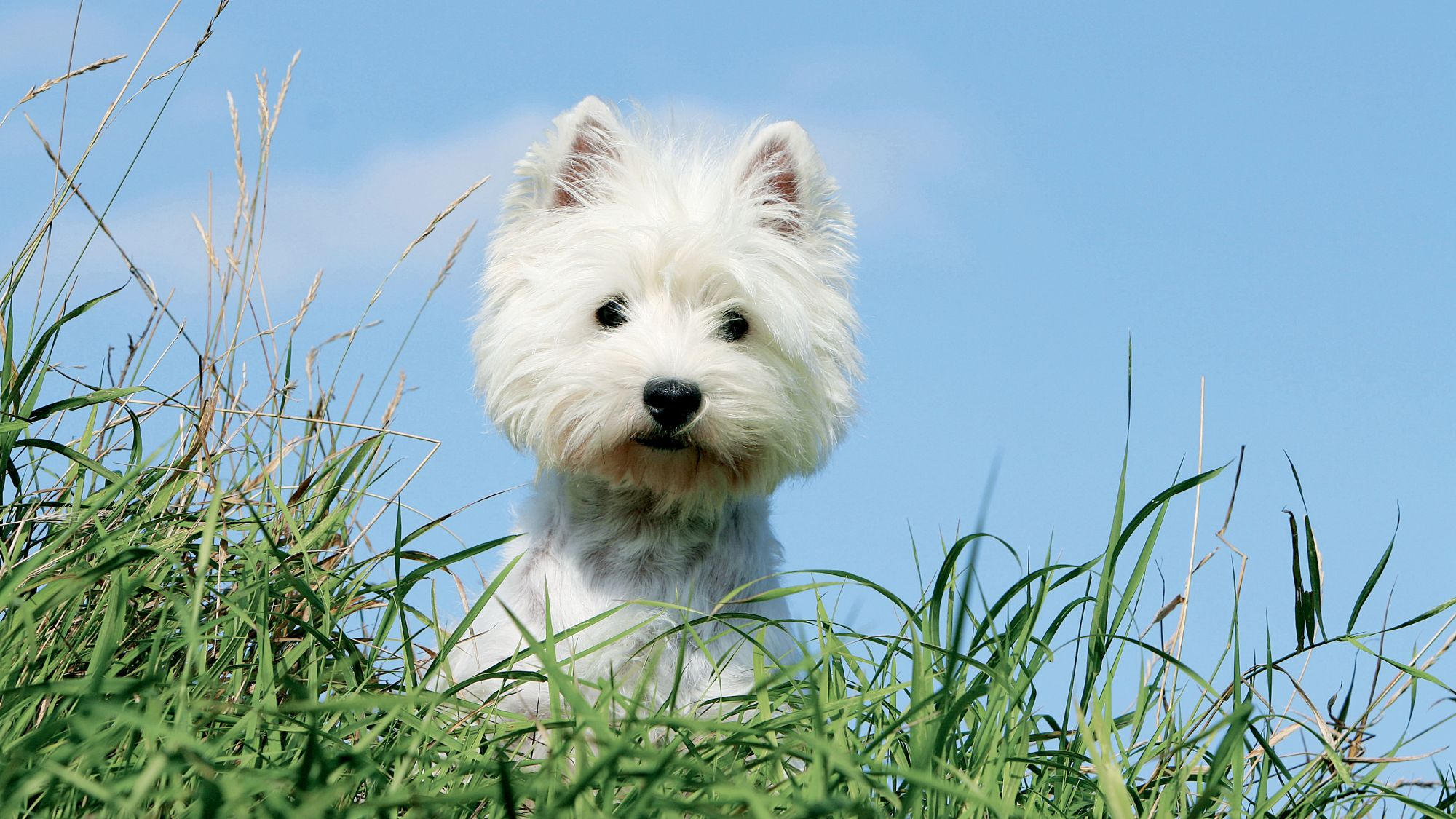
Caring for your West Highland White Terrier
Grooming, training and exercise tips
Given their background as working terriers, it’s perhaps not surprising that the West Highland White Terrier is quite a high-energy breed. The Westie therefore requires a reasonable amount of exercise each day. Shoot for a minimum of 30 minutes – but, ideally, up to an hour. A very friendly and sociable breed, Westies also enjoy playing games, chasing balls and meeting other dogs. Because of the Westie’s innate hunting instinct, care must be taken when letting them off the lead – unless you want to be retrieving them from a fox’s burrow – and they should also be kept away from any small animals.
With their thick double coat, comprising a coarse outer coat and a softer one underneath, daily grooming is important for the West Highland White Terrier. As well as the usual brushing, some owners also use a technique called stripping (or plucking) where the old, dead hair is gently pulled out – but others prefer to take them to a professional groomer every four to six weeks. On the plus side, the Westie’s shedding is on the lower side of average. Also, due to the specific nature of their outer coat, which contains few oils and is relatively resistant to dirt, baths will only be needed very occasionally. Teeth should ideally be brushed daily, nails clipped as needed and ears checked regularly.
A highly intelligent breed, the West Highland White Terrier is a quick learner – but it has to be said that they can also be a little bit stubborn. As working terriers, they were bred to operate alone, giving them their independent streak, and something of that spirit definitely resides in them today. On the plus side, the affable personality of the Westie means they respond well to reward-based training and positive reinforcement. Patience is the key! Once you’ve cracked the initial commands, Westies actually excel in a variety of canine sports, ranging from obedience and tracking to agility.
Given their background as working terriers, it’s perhaps not surprising that the West Highland White Terrier is quite a high-energy breed. The Westie therefore requires a reasonable amount of exercise each day. Shoot for a minimum of 30 minutes – but, ideally, up to an hour. A very friendly and sociable breed, Westies also enjoy playing games, chasing balls and meeting other dogs. Because of the Westie’s innate hunting instinct, care must be taken when letting them off the lead – unless you want to be retrieving them from a fox’s burrow – and they should also be kept away from any small animals.
With their thick double coat, comprising a coarse outer coat and a softer one underneath, daily grooming is important for the West Highland White Terrier. As well as the usual brushing, some owners also use a technique called stripping (or plucking) where the old, dead hair is gently pulled out – but others prefer to take them to a professional groomer every four to six weeks. On the plus side, the Westie’s shedding is on the lower side of average. Also, due to the specific nature of their outer coat, which contains few oils and is relatively resistant to dirt, baths will only be needed very occasionally. Teeth should ideally be brushed daily, nails clipped as needed and ears checked regularly.
A highly intelligent breed, the West Highland White Terrier is a quick learner – but it has to be said that they can also be a little bit stubborn. As working terriers, they were bred to operate alone, giving them their independent streak, and something of that spirit definitely resides in them today. On the plus side, the affable personality of the Westie means they respond well to reward-based training and positive reinforcement. Patience is the key! Once you’ve cracked the initial commands, Westies actually excel in a variety of canine sports, ranging from obedience and tracking to agility.
7/7
All about West Highland White Terriers
It’s true that West Highland White Terriers are not backward at coming forward when it comes to expressing themselves. But this is mainly for good reason – such as to announce the arrival of a stranger or something unexpected. So, if Westies do bark excessively, there is normally a logic to it.
As West Highland White Terriers form strong bonds with their owners, they shouldn’t be left alone for too long. Otherwise, your Westie may become distressed or exhibit destructive behaviour. Having another dog to keep them company can sometimes help.
Other breeds that might interest you
Read more on this topic
Sources
- Veterinary Centers of America https://vcahospitals.com/
- Royal Canin Dog Encyclopaedia. Ed 2010 and 2020
- Banfield Pet Hospital https://www.banfield.com/
- Royal Canin BHN Product Book
- American Kennel Club https://www.akc.org/
Like & share this page